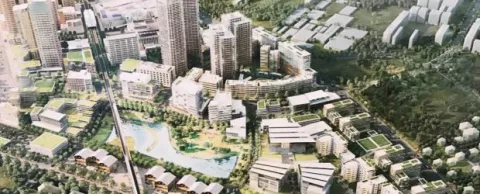
Some key components existed. Research institutions, a transit oriented development framework, private sector investment, a high-tech sustainable energy system, among other strategies. But a smart community? Well, not if you believe people and liveability need to be at the heart of your smart cities vision.
It is a story likely to become more familiar as our communities and cities organically grow, piece on piece. An observation I continue to make - a smart cities strategy that led with technology, only to leave behind the people.
In the case of Kashiwa-no-ha Smart City, Japan, it kind of kicked some goals, but you wouldn't claim it was a sustainable community, necessarily. It's aim is to build a futuristic smart city that harmonised people and the environment. But when you want people-first smart cities, there is a 'secret sauce', a set of ingredients, that need to be unearthed.
This secret sauce is place. And place is an experience, part feeling, part behavior. It involves the intersection of property development, governance, investment, and urban design, among other attributes.
Place meets Technology
So as the Kashiwa-no-ha Smart City sought to breathe greater life into its evolving 'tech-heavy' community, there was no better peer-city to support the challenge than Portland Oregon, in the United States.
Upon first glance, Charles Kelley of ZGF, who was leading the Portland-based team, said, "The community had a strong desire for meaning and purpose". He is steadfast in his views - "smart cities are not smart unless they are meaningful and purposeful, for people".
"Smart cities are not smart unless they are meaningful and purposeful".
"The smart city must have tangible experiences for people, not merely be a collection of abstract idea's", says Kelley. He acknowledges that many component parts were in place, that promoted sustainability - transit oriented development, deep research partnerships, energy management system. "But the neighbourhood setting did not support community life in any vital way," Kelley explains.
"Building a ‘commons’ platform for sustained vitality and exchange was critical, to bring meaning and context to the technology that had been deployed, and then how the community, and business, could interact with it and within the neighborhood’s form. For technology to be useful, it needs an engaged customer, a beneficiary, a community to benefit from it, with meaning", Kelley asserts.
As we shuffle through the sketches on his desk, he describes for me the challenge of transforming the real estate and infrastructure into an exchange platform. He shares the idea of building the 'commons' as the first layer of smart cities technology, ensuring open space is seen as a ‘system’. "And this starts with an active and vital street system", Kelley says.
Smart x Resilient Cities
Kelley says the Tohuko Earthquake on March 11, 2011 which lead to the Fukushima Daiichi Nuclear Power Plant disaster was a wakeup call. "The original Kashiwa-no-ha Smart City station area plan was adapted to demonstrate building resilience, to the next big event, and making sure the site can function and critical services remain online." Being able to function 'offline' during an unplanned disaster event has been supported by an area energy management system, sensors, battery storage and other technologies. Smart Cities Council Partner, Hitachi, has played a key role in this strategy.
At the heart of the community’s interest was to be more engaged with the local natural systems. An existing fenced stormwater detention pond becomes an active park. This happened through direct community advocacy. Aqua Terrace has now been built, a piece of a major green infrastructure overlay that manages drainage, but has been designed to catalyse residential lifestyles in common spaces that are also attractive to the creative industries pursuing technology solutions that enable these same social and economic development outcomes. Kashiwa-no-ha can be recognized as a model and laboratory for the value of green infrastructure to support businesses goals.
"We wanted to incubate a maker economy, around food and other services to the community", Kelley described. "It’s a shared economy within Kashiwa-no-ha. This supports national initiatives to provide jobs and job training connected by healthful outdoor spaces. They want to also live outside - it speaks to the aspirations within the growing elderly population and the expectations for young families with children."
"One of our smart cities metrics was - can a 12 year old cycle around the entire city?"
"Rectifying the unintended consequences from technology-led city building has been the task at Kashiwa-no-ha. And as a result we have found this wonderful synergy between creating engaging and resilient places for people to live and work, that has been enabled by world class urban design and technology."
Smart Cities Urbanism
Kelley is not shy about his discovery in Kashiwa-no-ha. "We have helped to form a test bed for future smart cities projects in Japan, and indeed around the world." Future community building processes can support real estate and public realm development to complement incremental advancement in smart city solutions.
Their approach was also one deeply rooted in the principles of tactical urbanism, where rapid-fire testing of concepts, technologies, and partnerships has led to more successful smart cities outcomes. The role of the Urban Design Center Kashiwa-no-ha (UDCK) as a consortium of public, private, and academic interests that test strategic and tactical solutions with the community is critical. UDCK now helps the community evaluate the meaning and purpose of technology and placemaking in the neighbourhood.
UDCK administers a collaborative governance process that holds it all together, Kelley explains. "Spreading the burden of transformation across all property owners was critical, which required an innovative approach involving land swaps and the like. This required deep collaboration through trust building and identifying mutually reinforcing goals."
Without connections between people, and places that are meaningful and purposeful, we will never truly have smart cities. As we wrap up the interview, Kelley ponders, and leaves me with one final nugget - "imagine how you build place, and then let technology follow, you can’t go wrong".



